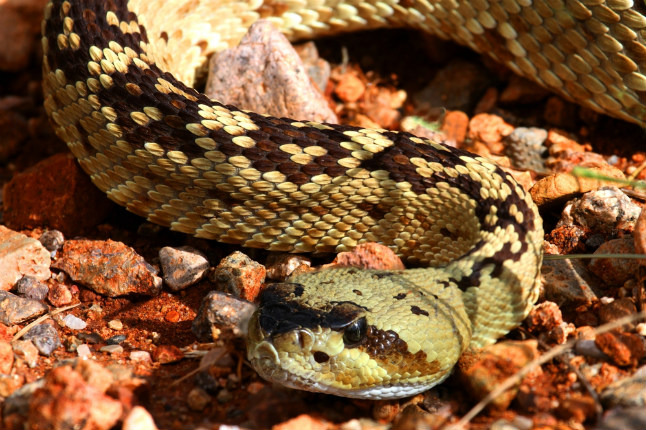How To Survive A Snakebite
In the height of summer, with many people enjoying the outdoors, accidents are bound to happen. One such accident that many hikers fear is a run-in with a venomous snake. Tony Nester, an expert on desert survival and head of Ancient Pathways Survival School, has had his fair share of encounters in 26 years of leading outdoor excursions. He shared his experience and knowledge with The Active Times.
With the warmer months upon hikers, it's not uncommon for there to be an increase in encounters with rattlesnakes, particularly in the western and southeastern U.S. which both have a healthy population of venomous creatures.
The golden rule that every wilderness traveler should remember: Don't put your hands and feet where you can't see. Most rattlesnake bites occur on the extremities as you are gathering firewood or stepping over a downed log or rock pile. According to research from the University of Arizona Toxicology Center, the majority of rattlesnake bite victims are male, 18-24 years of age and intoxicated. And out of the roughly 8,000 venomous bites that occur each year in the U.S., there are only eight to 15 fatalities.
The good news is that around 30% of rattlesnake bites are dry. Again, use caution when collecting firewood, employ a walking stick when traversing rocky terrain, and don't hike at night. Also be aware that a snake's bite reflex is intact for up two hours after it is dead. There have been cases where a driver has stopped to examine or handle a semi-flattened rattler on the highway and has been envenomated.
If you follow these tips and still get nailed by a venomous snake, your best remedy is your car keys, as in don't waste time on folk remedies or snakebite kits. Time=Tissue. Use good wound care management by flushing the bite site with water, covering the wound with a bandage and keep calm as you quickly get to the nearest hospital. Call ahead to let them know you have a snakebite victim so they can be prepared. You don't need to capture the snake or waste time trying to photograph it as some older survival manuals recommend.
The reason you want to avoid snakebite kits is because they do more harm than good by pooling the venom in one area. In one field experiment, a toxicologist envemonated live pigs with non-lethal doses of rattlesnake venom that was dyed purple. Immediately afterward numerous commercial snakebite kits were applied. Not only did he not get a single drop of venom out but the suction devices did more damage by concentrating the venom in one region of tissue than if it had been allowed to disperse. Snakebite kits, tourniquets, pressure wraps, or applying ice will only increase the tissue destruction.
If you are in a remote region days from help or a soldier who may be deployed without immediate evacuation then most researchers recommend sticking to good wound care management, treating for shock and avoiding constant movement. With so few fatalities in the U.S., statistics on our side and hopefully the bite you received was a dry one. Children are at greatest risk with venomous creatures (snakes, scorpions, bees, and spiders) because they have a smaller body mass to absorb the toxin.
During the past 26 years of guiding wilderness trips and survival courses, I've had a fair share of encounters with rattlesnakes but luckily no bites. Most of my brushes have been due to lack of situational awareness as I traversed a boulder field or rocky outcropping in the desert, often at the end of a long hike when I'm tired.
One time in younger days, while exploring a system of caves in central Arizona, I crawled into an opening to examine some prehistoric rock art, oblivious, in my zeal, to the "S" shaped patterns in the sand beneath me. With my body committed, I heard the deafening sound of a large rattlesnake poised on a ledge around 18 inches from my neck. He could have easily struck me but instead remained steady, vigorously scolding me with each flutter of his tail. Quickly deciding the bulls-eye on my carotid wasn't conducive to my health, I began withdrawing. With each micro-movement backwards that I made, the snake insisted that I tread excruciatingly slow. Operating at a Tai-Chi pace, I backed out of the cave over several minutes, emerging exhausted and soaked with sweat, but eternally grateful that the serpentine guardian of that dwelling was more interested in packrats than humans.
Related:
How to Survive a Shark Attack
How to Survive a Fast River Current
How to Survive a Bear Attack...Depends on the Bear
